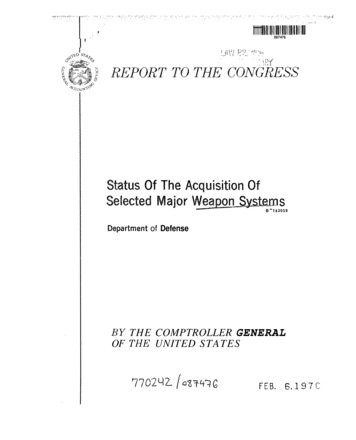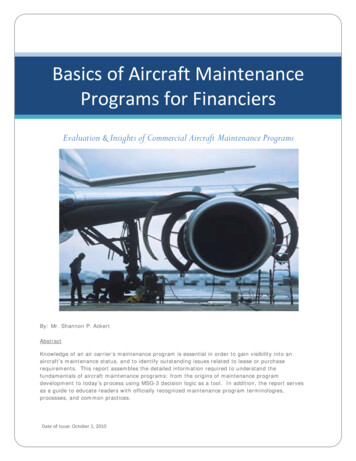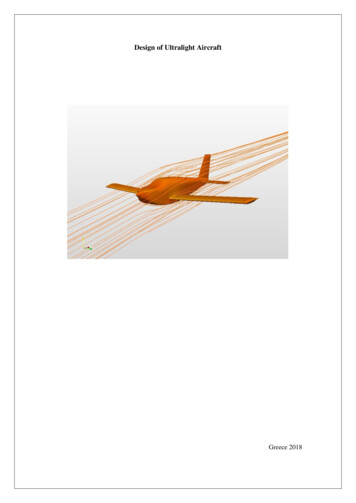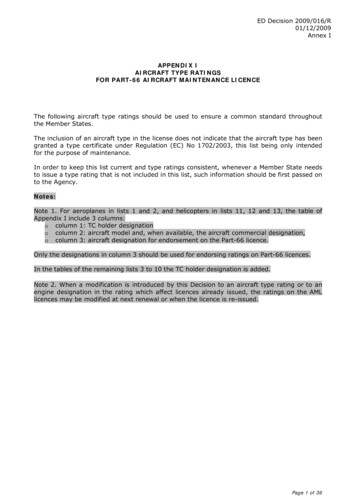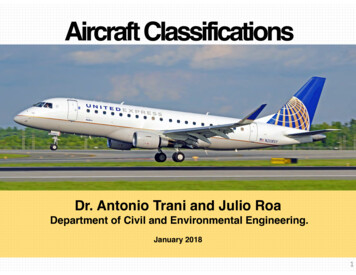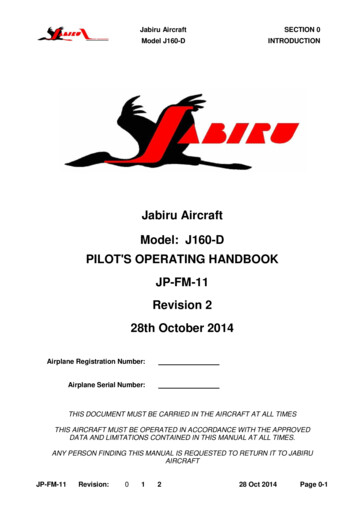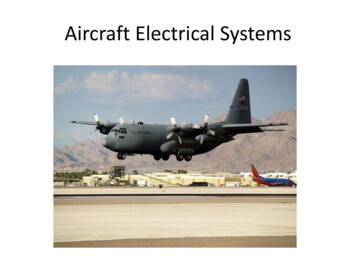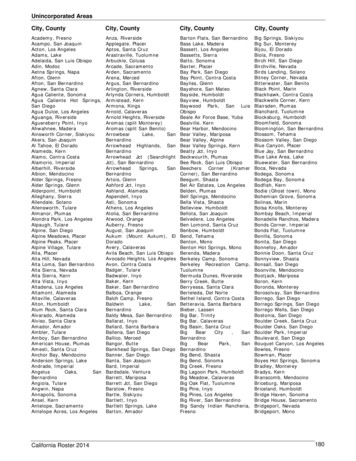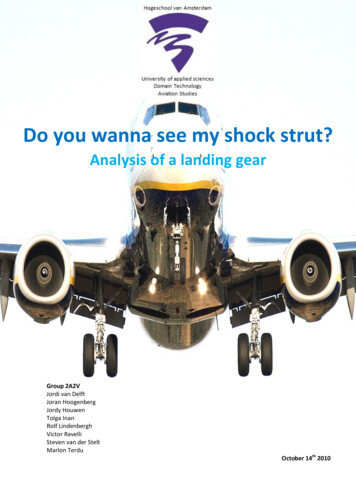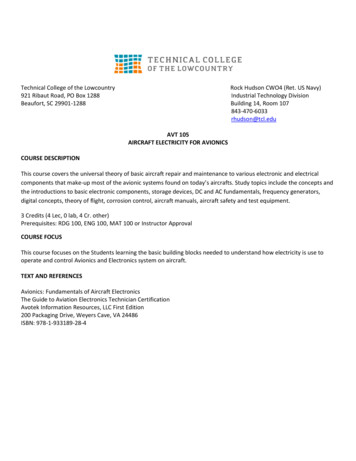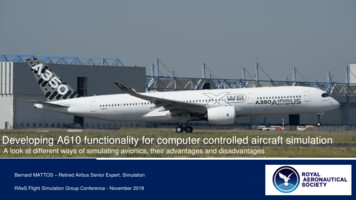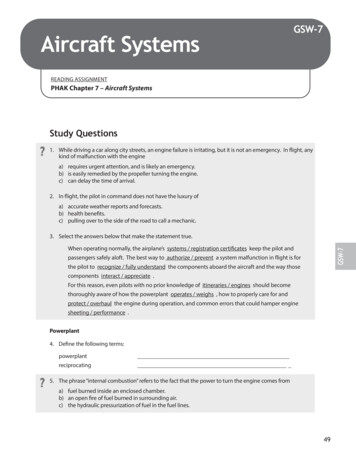
Transcription
Aircraft SystemsGSW-7READING ASSIGNMENTPHAK Chapter 7 – Aircraft SystemsStudy Questions?1. While driving a car along city streets, an engine failure is irritating, but it is not an emergency. In flight, anykind of malfunction with the enginea) requires urgent attention, and is likely an emergency.b) is easily remedied by the propeller turning the engine.c) can delay the time of arrival.2. In flight, the pilot in command does not have the luxury ofa) accurate weather reports and forecasts.b) health benefits.c) pulling over to the side of the road to call a mechanic.3. Select the answers below that make the statement true.GSW-7When operating normally, the airplane’s systems / registration certificates keep the pilot andpassengers safely aloft. The best way to authorize / prevent a system malfunction in flight is forthe pilot to recognize / fully understand the components aboard the aircraft and the way thosecomponents interact / appreciate .For this reason, even pilots with no prior knowledge of itineraries / engines should becomethoroughly aware of how the powerplant operates / weighs , how to properly care for andprotect / overhaul the engine during operation, and common errors that could hamper enginesheeting / performance .Powerplant4. Define the following terms:?powerplantreciprocating5. The phrase “internal combustion” refers to the fact that the power to turn the engine comes froma) fuel burned inside an enclosed chamber.b) an open fire of fuel burned in surrounding air.c) the hydraulic pressurization of fuel in the fuel lines.49
Aircraft Systems6. The most popular reciprocating engines used in smaller aircraft have what arrangement of cylinders?a) cylinders arranged in a line.b) horizontally-opposed cylinders.c) cylinders arranged in a circle.7. Check the boxes next to the strokes (of a four-stroke operating cycle) for which the given conditions exist.(Check all that apply.)Exhaust valve openPiston squeezing cylinder volumeIntake valve openPiston expanding cylinder volumeFuel & oxygen entering the cylinderCylinder powering the engineEngine power driving the cylinderExhaust gases leaving the cylinder intake intake intake intake intake intake intake intake compression compression compression compression compression compression compression compression power power power power power power power power exhaust exhaust exhaust exhaust exhaust exhaust exhaust exhaust8. How is continuous turning of the engine maintained throughout the four strokes?a) Electric power turns the shaft during the intake, compression, and exhaust strokes.b) Precise timing of the power strokes in each cylinder, so that at any time one cylinder is creating power.c) Oil provides for frictionless turning of the engine, so that it can coast through the three down strokes.Propeller9. The propeller is a rotating airfoil, subject to.10. Because the propeller is angled to be in line with the direction of motion, the total “lift” created by apropeller is more commonly known asa) thrust.b) horizontal lift.c) reverse drag.?11. The amount of lift (thrust) created by each piece of the propeller is determined individually using the liftequation. How will the lift generated by a piece at the tip of the propeller differ from a piece near the root?a) The piece at the tip will be experiencing significantly higher relative airspeed and will generate mostof its lift from airspeed.b) The piece at the tip will travel at the same speed as every other piece of the propeller.c) The angle of attack at the tip of the propeller is usually significantly higher than at the root, andtherefore a piece at the tip will generate most of its lift from angle of attack.12. On a fixed-pitch propeller, the angle of attack does not change from root to tip.a) Trueb) False13. A fixed-pitch propeller that has been designed for climb performance will have a pitch,and will result in r.p.m. and horsepower capability for takeoffsand climbs.50
Aircraft Systems14. A fixed-pitch propeller that has been designed for cruise performance will have a pitch,and will result in r.p.m. and efficiency during cruising flight.15. In aircraft equipped with a fixed-pitch propeller, the rotation speed of both the engine and propeller isindicated on the .16. How can engine and propeller speed be increased?a) Use the yoke to pitch the nose of the airplane up from the horizon.b) Use the RPM knob on the engine tachometer gauge to increase rotation speed.c) Use the throttle to increase the total amount of fuel/air mixture available to the engine.an adjustable pitch propeller, what is the actual change that takes place in the propeller?17. Ona) The blades of the propeller rotate to increase or decrease the pitch along the entire blade.b) The propeller blades lengthen on the side of the aircraft one which more power is required.c) The nose of the airplane moves forward and aft to push the entire propeller blade unit toward or awayfrom the engine housing.18. Using the propeller control, the pilot chooses a desired target RPM for the propeller and aautomatically adjusts the propeller blade angle as necessary to maintain theselected RPM.GSW-7a) horsepower linkb) governorc) pitch stop19. Airplanes equipped with constant-speed propellers have two controls.and20. On airplanes equipped with constant-speed propellers, engine power output is indicated on the.Induction Systems21. The purpose of the induction system is to bring in from outside, mixit with , and deliver it to the cylinder for combustion.22. The two most common small airplane induction systems area) carbureted and fuel-injected systems.b) filtered and unfiltered air systems.c) float-type and fuel pump systems.?23. In a float-type carburetor (the most common carburetor found in small aircraft), air flowing througha narrow throat (or “venturi”) creates a low pressure area that pulls fuel into the passing air.The phenomenon that explains this low pressure area isa) Bernoulli’s principle.b) Newton’s law of pressure.c) the carburetor effect.51
Aircraft Systems24. The large flap that swivels to open or close the amount of fuel and air that make it into the engine is calledthe .an automobile with a carburetor, what is attached via cable to the throttle valve to allow the driver to25. Oncontrol the overall amount of fuel and air reaching the engine?26. In an airplane, the controls the overall amount of fuel and air thatreaches the engine, but the allows the pilot to adjust the ratio offuel to air for changes in air density.27. A fuel/air ratio that has too much fuel for the amount of air available is called. A fuel/air ratio that has too little fuel for the amount of airavailable is called .28. Leaning the mixture decreases the fuel flow and compensates for thea) decreased air density at high altitude.b) increased air density at high altitude.c) reduced fuel vaporization rate at high altitude.29. During a descent from high altitude, what control change is important to prevent abnormal combustion orengine failure?would the pilot use the mixture control during runup at high altitude airports?30. Howa) Not at all. Leaning is only for enroute flight and at high altitudes.b) The pilot would enrich the mixture to improve engine performance.c) The pilot would lean the mixture during runup to prevent engine roughness and fouling of the sparkplugs.31. Which of the following best describes carburetor icing?a) Ice or snow that gets sucked into the engine from outside in winter.b) Ice forming in the fuel lines that prevents fuel flow to the carburetor.c) Ice that flash-freezes in the carburetor from moisture in the passing air through the venturi.32. If carburetor ice is occurring in an airplane with a fixed-pitch propeller, the first indication will be a decreasein .33. Ice can build up in the carburetor when outside conditions include high humidity or visible moisture andoutside air temperatures ranging froma) -50 F to 0 F.b) 0 F to 20 F.c) 20 F to 70 F.52
Aircraft Systems34. Carburetor heat is an anti-icing system thata) runs electrical current through the carburetor to warm the fuel.b) preheats the air before it reaches the carburetor.c) blocks moisture-laden air from reaching the carburetor.35. What is the impact of the use of carburetor heat on the fuel/air mixture flowing to the engine?a) Using carburetor heat causes a decrease in engine power, because the air flowing to the engine iswarmer and less dense, and there are fewer air molecules available for combustion.b) Using carburetor heat warms the fuel/air mixture, improving overall engine performance.c) Using carburetor heat increases the amount of air molecules available for combustion and enriches themixture.takeoff, a pilot tests whether carburetor heat is working by applying full carburetor heat and36. Beforelooking for what indication?a) A decrease in power output of the engine.b) A rise in engine oil temperature.c) An increase in exhaust gas temperature.37. Application of carburetor heat to melt ice in an airplane equipped with a fixed-pitch propeller shouldresult in two indications. First, the RPM will as the carburetor heat enriches themixture, then the RPM will as the ice melts and more fuel/air mixture can get tothe engine.GSW-7a) increase; decreaseb) increase; increasec) decrease; increasemost airplanes equipped with carburetor heat, why does the POH specify that the carburetor heat38. Inshouldbe off for takeoffs, climbs, and go-arounds?39. In a fuel injected system, fuel is sprayed through discharge nozzles located where?40. Which of the following is a potential disadvantage of using a fuel-injected engine?a) It may be difficult to start up an engine that is still hot from a previous flight.b) The external air intake is more likely to be blocked by induction icing.c) Mixture control is more difficult to control accurately.41. What is the basic principle behind superchargers and turbosuperchargers?a) Air passing through the supercharger is electrically charged to improve combustion.b) Superchargers compress the intake air to increase its density.c) At very high velocities, additional air intakes open bringing more air to the engine.53
Aircraft SystemsIgnition System?42. In aircraft electrical systems, the battery directly powers the spark plugs to start the engine.a) True.b) False.43. A standard dual ignition system has magneto(s) powered by the engine andspark plug(s) in each cylinder.44. During a pretakeoff check of the ignition system, which of the following would indicate normal functioningas the ignition switch is moved from Both to Right?a) No drop in RPM.b) A small decrease in engine RPM.c) A large RPM drop or the engine stops running.Oil Systems45. List five ways that internal combustion engines benefit from oil circulation.1.4.2.5.3.46. Fill in the blanks to indicate the conditions that can contribute to excessively high oil temperatures. A oil line. Oil quantity that is too .Engine Cooling Systems47. Most small aircraft engines are cooled bya) air flowing into the engine compartment.b) liquid coolant.c) oil compressors.48. During what phases of flight is the air cooling system less effective at removing engine heat?(Check all that apply.) ground operations takeoffs high-speed cruise high-power, low-airspeed operations descents49. Operating the engine at higher than its designed temperature can causea) improved engine performance.b) better maneuverability and longitudinal stability.c) loss of power, excessive oil consumption, detonation, and serious permanent damage to the engine.54
Aircraft Systems50. are hinged covers that fit over the opening through which hot airfrom the engine is expelled. When closed, they restrict the flow of expelled hot air and increase enginetemperature.Starting System51. How are starter motors NOT powered?a) By generators mounted on the engine.b) By external power supplied through an external power receptacle.c) By the battery.?52. Which of the following would never be found on older, antique airplanes that are not equipped withelectrical systems?a) Flaps.b) Starter motors.c) Fuel pumps.Combustion53. Is it more accurate to say that “fuel is burned” or that “fuel is exploded” in an internal combustion engine?54. In a carefully tuned engine, the expanding gases deliver the maximum force to the piston?GSW-7a) whenever the pilot enrichens the mixture.b) at exactly the right time in the power stroke.c) at any time.55. Which of the following phrases best captures what is happening to the fuel mixture during detonation?a) “Explodes”.b) “Fizzles”.c) “Softens”.56. Fill in the blanks to indicate the conditions that can contribute to detonation. Operating with the engine at very high power settings and an excessivelymixture. Using fuel that is of a grade than specified by the manufacturer. Steep climbs, or extended ground operations where is reduced.57. The fuel/air mixture in the cylinder igniting prior to the engine’s normal ignition event is calleda) proto-combustion.b) pre-empowerment.c) pre-ignition.55
Aircraft Systems58. What is a likely cause of preignition?a) Magneto key switch stuck in the off position.b) A hot spot in the cylinder.c) A stuck exhaust valve.Fuel Systems59. What force of nature helps deliver fuel to the engine from fuel tanks in the wings of high-wing airplanes?60. Airplanes with fuel pump systems usually have one pump powered byand another powered by .61. Why are fuel tanks vented?a) To allow air to flow into the tank to replace the outgoing fuel.b) To prevent the possibility of fire.c) To allow overflow fuel (caused by expansion of the fuel) to spill out and not damage the tank.62. Why do fuel tanks have an overflow drain?a) To allow air to flow into the tank to replace the outgoing fuel.b) To prevent the possibility of fire.c) To allow overflow fuel (caused by expansion of the fuel) to spill out and not damage the tank.63. In what conditions would fuel likely flow out of the overflow drain of an airplane?64. If an airplane is experiencing vapor lock on a hot day, what is the most likely cause?a) Water that has condensed into the fuel tanks from water vapor in the air.b) Air from the outside that has crept into the fuel system via leaks.c) A bubble of fuel that has vaporized in the fuel lines due to excessive heat.is the most likely danger of taking off without first checking fuel sumps and strainers?65. Whata) The previous pilot may have inadvertently left the strainer drain open.b) Water or contaminants in the fuel system could cause the engine to stop in flight.c) There is no way to accurately check the amount of fuel except at the fuel sumps, and you might notnotice that the airplane is out of fuel.66. What color is AVGAS 100LL?56
Aircraft SystemsPOH calls for AVGAS 80, but only AVGAS 100 is available, what should you do?67. Ifa)yourWaitairplaneuntil the exact fuel called for in the POH is available.b) You may use fuel of a higher grade as a substitute, so AVGAS 100 is okay.c) Mix 4 parts AVGAS 100 with 1 part water to get AVGAS 80.68. Why should fuel tanks be filled after each flight, or at least after the last flight of the day?a) To prevent water condensation in the tanks.b) To allow the next pilot to skip the fuel system portion of the preflight inspection.c) To guard against fuel price increases.Heating System69. The most common type of heating used on most light aircraft isa) Fuel-fired heatersb) Exhaust heating systemsc) Gloves and jackets70. A risk of a defective exhaust heating system isa) Lower aircraft performanceb) Carbon monoxide poisoningc) Increased potential for fireElectrical SystemGSW-771. What are the basic advantages of an alternator over a generator?a) An alternator can create electric energy even while the engine is not turning.b) Only an alternator can create the direct current used by most avionics.c) An alternator can produce sufficient current even at slower engine speeds, and the output is moreconstant.72. Which gauge shows whether the battery is charging or discharging?a) Bus bar.b) Loadmeter.c) Ammeter.?73. Name two ways to detect an alternator failure?airplane is equipped with a 24-volt battery, what is it also likely to have?74. Ifa)an12-voltgenerator/alternator.b) 24-volt generator/alternator.c) 28-volt generator/alternator.57
Aircraft SystemsLanding Gear75. Which of the following is an advantage in tailwheel airplanes?a) Better forward visibility for the pilot during takeoff, landing, and taxiing.b) More ground clearance for the propeller.c) Allows more forceful application of the brakes without nosing over.76. The reduction of what aerodynamic factor justifies the addition of a retractable landing gear system?a) Cruise airspeed.b) Centrifugal force.c) Drag.58
Aircraft SystemsAnswers to Study Questions7. Exhaust valve openPiston squeezing cylinder volumeIntake valve openPiston expanding cylinder volumeFuel & oxygen entering the cylinderCylinder powering the engineEngine power driving the cylinderExhaust gases leaving the cylinder8. b9. induced drag, stalls, and other aerodynamicprinciples that apply to any airfoil10. a11. a12. b (false)13. lowerhighermore14. higherlowerincreased15. tachometer16. c17. a18. b19. throttlepropeller control20. manifold pressure gauge21. airfuel22. a23. a24. throttle (or throttle valve)4. the complete engine and propeller systems of anairplane with accessoriesthe back-and-forth movement of pistons5. a6. b intake intake X intake X intake X intake intake X intake intake compression X compression compression compression compression compressionX compression compression power power power X power power X power power power X exhaust X exhaust exhaust exhaust exhaust exhaust X exhaust X exhaust25. the accelerator pedal26. throttlemixture control27. richlean28. a29. the mixture should be enriched30. c31. c32. engine RPM33. c34. b35. a36. a37. c38. Carburetor enriches the mixture and reducesengine output, and should be turned off when fullengine power is needed.39. in the cylinders or just ahead of the intake valve40. a41. bGSW-71. a2. c3. systemspreventfully e59
Aircraft SystemsAnswers to Study Questions42. b. False43. twotwo44. b45. lubrication of moving partscooling by reducing frictionremoving heat from cylindersseal between piston and cylindercarrying away contaminants46. pluggedlow47. a48.49.50.51.52.53.54.55.56.60X ground operations X takeoffs high-speed cruiseX high-power, low-airspeed operations descentscCowl flapsab“Fuel is burned.”baleanlowercylinder 1.72.73.74.75.76.cbGravitythe enginean electric motoracwhen fuel expands in the tanks after refueling ona hot daycbbluebaExhaust heating systemsAll of the abovecca minus indication of an ammeter indicatingdischarge of the batteryan alternator warning light (or low voltagelight)cbc
PHAK Chapter 7 - Aircraft Systems Aircraft Systems GSW-7. 50? 6. The most popular reciprocating engines used in smaller aircraft have what arrangement of cylinders? a) cylinders arranged in a line. b) horizontally-opposed cylinders. c) cylinders arranged in a circle. 7. Check the boxes next to the strokes (of a four-stroke operating cycle .
